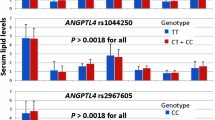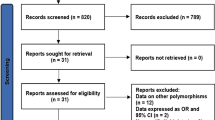Abstract
Purpose
Dysregulation of angiogenesis and inflammation play important roles in the development of atherosclerosis. Rosuvastatin (RST) was widely used in atherosclerosis therapy. Genetic variations of transporters may affect the rosuvastatin concentration in plasma and reflect different clinical treatment. The aim of this study was to explore the drug transport related single-nucleotide polymorphisms (SNPs) on RST pharmacokinetic and the further on pro-angiogenic and pro-inflammatory factors.
Methods
A total of 269 Chinese patients with hypercholesterolemia and diabetes mellitus were enrolled. They were treated with RST to lower cholesterol. The plasma concentration of RST was determined using a validated UPLC-MS/MS method. Seven single-nucleotide polymorphisms (SNPs) in six genes were genotyped using the Sanger dideoxy DNA sequencing method. The serum concentrations of inflammation markers were determined using ELISA kits.
Results
ABCG2 421C > A (rs2231142) and SLCO1B1 521 T > C (rs4149056) variations were highly associated with plasma concentrations of RST (P < 0.01, FDR < 0.05). The serum MCP-1, sVCAM-1, and TNF-α levels were significantly different between the ABCG2 421C > A and SLCO1B1 521 T > C genetic variation groups (P < 0.01). RST concentration was negatively correlated with sVCAM-1 concentration (r = 0.150, P = 0.008).
Conclusion
ABCG2 421C > A (rs2231142) and SLCO1B1 521 T > C (rs4149056) genetic variants affect RST concentration significantly and potentially affect serum levels of pro-inflammatory and pro-angiogenic markers. The effects on anti-inflammation might not be related to high plasma exposure of RST.


Similar content being viewed by others
References
Ioannidis JPA (2014) More than a billion people taking statins? Potential implications of the new cardiovascular guidelines[J]. JAMA 311(5):463–464
Stone NJ, Robinson JG, Lichtenstein AH, Bairey Merz CN, Blum CB, Eckel RH et al (2014) 2013 ACC/AHA guideline on the treatment of blood cholesterol to reduce atherosclerotic cardiovascular risk in adults: a report of the American College of Cardiology/American Heart Association task force on practice guidelines. J Am Coll Cardiol 63:2889–2934
Shin SK, Cho JH, Kim EJ, Kim EK, Park DK, Kwon KA, Chung JW, Kim KO, Kim YJ (2017) Anti-inflammatory and anti-apoptotic effects of rosuvastatin by regulation of oxidative stress in a dextran sulfate sodium-induced colitis model. World J Gastroenterol 23(25):4559–4568
Kırzıoğlu FY, Tözüm Bulut M, Doğan B, Fentoğlu Ö, Özmen Ö, Çarsancaklı SA, Ergün AG, Özdem M, Orhan H (2017) Anti-inflammatory effect of rosuvastatin decreases alveolar bone loss in experimental periodontitis. J Oral Sci 59(2):247–255
Volonte D, Liu Z, Musille PM, Stoppani E, Wakabayashi N, Di YP, Lisanti MP, Kensler TW, Galbiati F (2013) Inhibition of nuclear factor-erythroid 2-related factor (Nrf2) by caveolin-1 promotes stress-induced premature senescence. Mol Biol Cell 24(12):1852–1862
Rashidian A, Muhammadnejad A, Dehpour AR, Mehr SE, Akhavan MM, Shirkoohi R, Chamanara M, Mousavi SE, Rezayat SM (2016) Atorvastatin attenuates TNBS-induced rat colitis: the involvement of the TLR4/NF-kB signaling pathway. Inflammopharmacology. 24(2–3):109–118
Shen DZ, Xin SL, Chen C, Liu T (2013) Effect of atorvastatin on expression of TLR4 and NF-κB p65 in atherosclerotic rabbits. Asian Pac J Trop Med 6(6):493–496
Martínez-Hervás S, Sánchez-García V, Herrero-Cervera A, Vinué Á, Real JT, Ascaso JF, Burks DJ, González-Navarro H (2019) Type 1 diabetic mellitus patients with increased atherosclerosis risk display decreased CDKN2A/2B/2BAS gene expression in leukocytes. J Transl Med 17(1):222
Rastad H, Parsaeian M, Shirzad N, Mansournia MA, Yazdani K (2019) Diabetes mellitus and cancer incidence: the atherosclerosis risk in communities (ARIC) cohort study. J Diabetes Metab Disord 18(1):65–72
Katakami N (2018) Mechanism of development of atherosclerosis and cardiovascular disease in diabetes mellitus. J Atheroscler Thromb 25(1):27–39
Dworacka M, Krzyżagórska E, Wesołowska A, Zharmakhanova G, Iskakova S, Dworacki G (2014) Circulating monocyte chemotactic protein 1 (MCP-1), vascular cell adhesion molecule 1 (VCAM-1) and angiogenin in type 2 diabetic patients treated with statins in low doses. Eur J Pharmacol 740:474–479
Arrigoni E, Del Re M, Fidilio L, Fogli S, Danesi R, Di Paolo A (2019) Pharmacogenetic foundations of therapeutic efficacy and adverse events of statins. Expert Opin Drug Metab Toxicol 15(4):313–328
Wan Z, Wang G, Li T, Xu B, Pei Q, Peng Y, Sun H, Cheng L, Zeng Y, Yang G, Zhu YS (2015) Marked alteration of Rosuvastatin pharmacokinetics in healthy Chinese with ABCG2 34G>a and 421C>a homozygote or compound heterozygote. J Pharmacol Exp Ther 354(3):310–315
Safar Z, Kis E, Erdo F, Zolnerciks JK, Krajcsi P (2019) ABCG2/BCRP: variants, transporter interaction profile of substrates and inhibitors. Expert Opin Drug Metab Toxicol 15(4):313–328
Bai X, Zhang B, Wang P, Wang GL, Li JL, Wen DS, Long XZ, Sun HS, Liu YB, Huang M, Zhong SL (2019) Effects of SLCO1B1 and GATM gene variants on rosuvastatin-induced myopathy are unrelated to high plasma exposure of rosuvastatin and its metabolites. Acta Pharmacol Sin 40(4):492–499
Gelissen IC, McLachlan AJ (2014) The pharmacogenomics of statins. Pharmacol Res 88:99–106
Shitara Y, Maeda K, Ikejiri K, Yoshida K, Horie T, Sugiyama Y (2013) Clinical significance of organic anion transporting polypeptides (OATPs) in drug disposition: their roles in hepatic clearance and intestinal absorption. Biopharm Drug Dispos 34(1):45–78
Lee HK, Hu M, Lui S, Ho CS, Wong CK, Tomlinson B (2013) Effects of polymorphisms in ABCG2, SLCO1B1, SLC10A1 and CYP2C9/19 on plasma concentrations of rosuvastatin and lipid response in Chinese patients. Pharmacogenomics. 14(11):1283–1294
Xiang Q, Chen SQ, Ma LY, Hu K, Zhang Z, Mu GY, Xie QF, Zhang XD, Cui YM (2018) Association between SLCO1B1 T521C polymorphism and risk of statin-induced myopathy: a meta-analysis. Pharmacogenomics J 18(6):721–729
Barkas F, Elisaf M, Liberopoulos E, Liamis G, Ntzani EE, Rizos EC (2019) Atherogenic dyslipidemia increases the risk of incident diabetes in statin-treated patients with impaired fasting glucose or obesity. J Cardiol. https://doi.org/10.1016/j.jjcc.2019.02.009
Kurihara O, Thondapu V, Kim HO, Russo M, Sugiyama T, Yamamoto E, Fracassi F, Minami Y, Wang Z, Lee H, Yonetsu T, Jang IK (2019) Comparison of vascular response to statin therapy in patients with versus without diabetes mellitus. Am J Cardiol 123(10):1559–1564
Reddy S, Amutha A, Rajalakshmi R, Bhaskaran R, Monickaraj F, Rangasamy S, Anjana RM, Abhijit S, Gokulakrishnan K, Das A, Mohan V, Balasubramanyam M (2017) Association of increased levels of MCP-1 and cathepsin-D in young onset type 2 diabetes patients (T2DM-Y) with severity of diabetic retinopathy. J Diabetes Complicat 31(5):804–809
Bahrami A, Parsamanesh N, Atkin SL, Banach M, Sahebkar A (2018) Effect of statins on toll-like receptors: a new insight to pleiotropic effects. Pharmacol Res 135:230–238
Taleb S (2016) Inflammation in atherosclerosis. Arch Cardiovasc Dis 109(12):708–715
Tousoulis D, Oikonomou E, Economou EK, Crea F, Kaski JC (2016) Inflammatory cytokines in atherosclerosis: current therapeutic approaches. Eur Heart J 37(22):1723–1732
Funding
This study was supported by the National Natural Science Foundation of China (Grant no. 81503339).
Author information
Authors and Affiliations
Contributions
DZ: analyzed data and wrote the manuscript. YMD, XXW, WYX, WWD and WQC: contributed to the development, interpretation of results. XLZ and PML revision of the manuscript.
Corresponding author
Ethics declarations
The protocol for study was approved by the Bioethical Committee of China-Japan Friendship Hospital and all the participants gave informed consent.
Conflict of interest
The authors declare that they have no conflict of interest.
Additional information
Publisher’s note
Springer Nature remains neutral with regard to jurisdictional claims in published maps and institutional affiliations.
Electronic supplementary material
ESM 1
(DOCX 16 kb)
Rights and permissions
About this article
Cite this article
Zhang, D., Ding, Y., Wang, X. et al. Effects of ABCG2 and SLCO1B1 gene variants on inflammation markers in patients with hypercholesterolemia and diabetes mellitus treated with rosuvastatin. Eur J Clin Pharmacol 76, 939–946 (2020). https://doi.org/10.1007/s00228-020-02882-4
Received:
Accepted:
Published:
Issue Date:
DOI: https://doi.org/10.1007/s00228-020-02882-4




